However, Mandalay is a really outstanding
destination mainly because of what lies immediately around it: the ruins of
much older cities and religious sites sit decaying in an antique landscape. We
took a boat trip 10 km up the Irrawaddy to Mingun, gliding past a timeless
scene of bullocks ploughing a tapestry of fields on our way, to see the remains
of a massive, half-built pagoda abandoned in 1819. Moving south, we crossed the
little Myitnge River and explored the ancient capital of Inwa (or Ava) by horse
cart, clopping in dappled shade along rural lanes to monasteries and a
watchtower now standing amid paddy fields. The great palace at Inwa no longer
stands: it was recycled as a kilometer-long teak footbridge that leads across
Taungthaman Lake to Amarapura, which became the royal capital in 1783. We
walked the length of this winding structure, known as U Bein Bridge after its
master builder, stopping here and there to talk to monks from Amarapura’s huge
Mahagandayon Monastery at the foot of the striking monument. The young,
saffron-robed men smilingly told us they were keen to improve their English and
to that purpose were sent out by their elders in the late afternoons to meet
tourists and visit local internet cafes – of which there are a growing number, thanks
to a new university nearby, although getting serve access is currently a slow
and frustrating exercise.
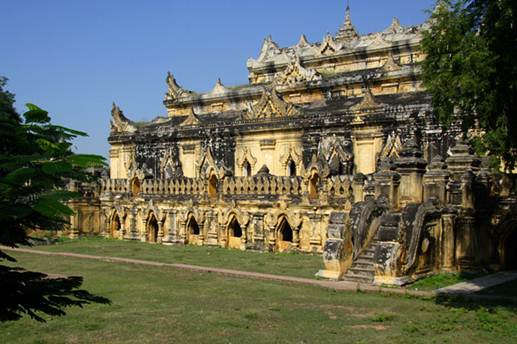
the
ancient capital of Inwa (or Ava)
We flew on to Bagan later that day, and arrived in the dark. We woke the next morning
to find ourselves in what seemed like an ethereal theme park of Burmese history
and extraordinary beauty. Between the 11th and 13th
centuries, Bagan was Burma’s capital, and a jaw-droppingly glorious one.
Pointedly mixing religion with politics, the era’s 14 kings built 3,000 monuments
(probably many more, lost over time) in roughly 50 square kilometers, and their
nobles followed suit on a less ostentatious scale. Our archaeologist guide took
us to what are conventionally considered the major sights: the wonderful golden
Shwezigon Pagoda, dating from the 11th century; the great Ananda
Temple containing hundreds upon hundreds of Buddha statues; Nanpaya Pagoda with
terrific stone carvings (possibly a Hindu temple in origin). We gazed amazed at
the murals of Gubyaukgyi, Thambula, and the late-12th-century Lo
Kahteikpan. Best of all, he then took us off the beaten track, unlocking the
gates of several more pagodas where the paintings are almost unknown. Even
though many of the Bagan monuments have disintegrated over the centuries, it would
take a lifetime, he said, to examine all those remaining. At dusk we climbed
Shwesandaw Pagoda to watch a breathtakingly lovely sunset over a wide plain
dotted as far as the eye could see with an array of bell-shaped temples.
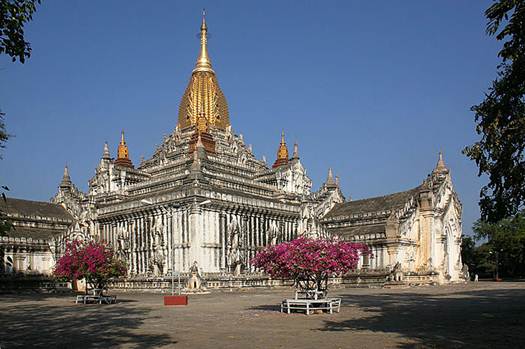
the
great Ananda Temple
Tourism in Bagan, however, is not without
controversy. When I first visited the district in the 1970s there were villages
in what is now the designated archaeological zone. In the 1990s the residents
were relocated in the name of conservation, and indeed tourism. That might have
been deemed a worthy, if difficult, undertaking were it not for the fact that a
few modern constructions were subsequently built, and here and there they now
mar the horizon.
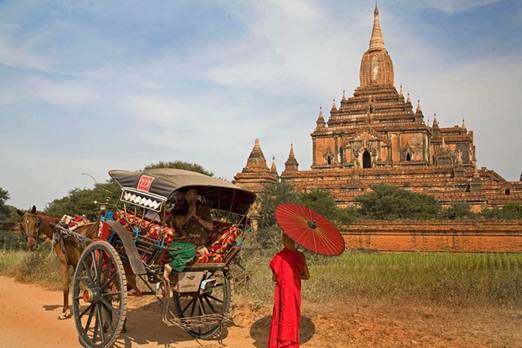
Horse
cart in Bagan
Returning to Rangoon, I had tea with an old
friend, who is member of the National League for Democracy. She drew my
attention to her party’s line on tourism. They are well aware that communities
have been harmed by the interests of this growing industry, that getting the
ideal balance between new jobs, economic development and environmental issues
is extremely tricky and that the wrong sort of visitor can cause serious harm –
such as the effects of sex tourism in neighbouring Thailand. On the other hand,
in the right circumstances tourism can boost the arts, culture and
conservation. In this respect and many others, Burma is on the cusp.
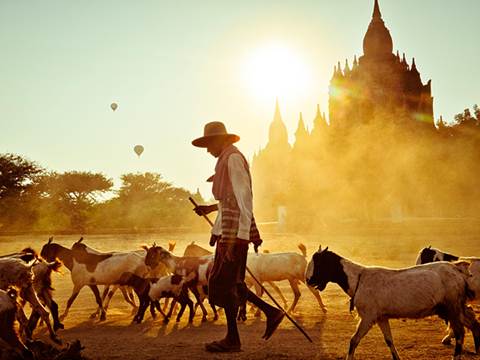
A
farmer herds goats near a Buddhist temple in Bagan
We had one evening left in the country, and
spent much of it at the Shwedagon Pagoda. As the sun set we sat on the marble
pavement watching the golden stupa gain ever-greater depth of colour against
the darkening sky. The air was suffused with the intonations of a monk uttering
prayers and extolling a list of good deeds. It encapsulated a pervading sense
of hope. “Thadu, thadu, thadu,” he chanted – it is good, it is good, it is
good.
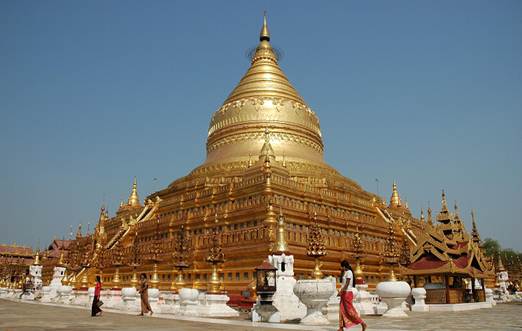
the
Shwedagon Pagoda